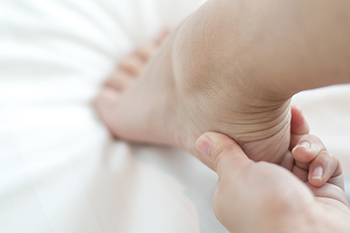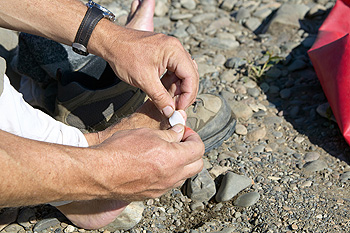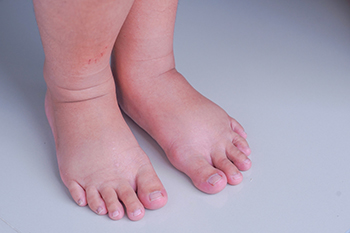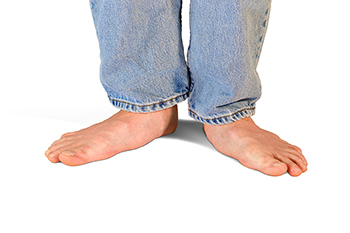July 2022
When Your Child Has Sever’s Disease

A condition called Sever’s disease actually sounds worse than it is. It is a harmless, though temporarily painful, condition that usually affects children between the age of 8 and 13 who are physically active. The good news is that with the right treatment and a bit of time, it will go away in most cases. Medically termed calcaneal apophysitis, Sever’s disease is the inflammation of the growth plate in the heel. Repetitive stress from running and jumping, or other high-impact activities, affects the area at the back of the heel that is not fully developed. Additional stress from the pulling of the Achilles tendon exacerbates the condition. Your child may complain of pain and some swelling under the heel. Rest from the activity causing the pain is usually the first recommendation. Heel padding in the shoes may also help in mild cases, along with certain exercises to stretch the calf muscles. If you have a child who participates in sports, it is a good idea to develop a relationship with a podiatrist who can oversee their foot development and treat foot or ankle problems as they arise.
Sever's disease often occurs in children and teens. If your child is experiencing foot or ankle pain, see one of our podiatrists from Bazzi Podiatry. Our doctors can treat your child’s foot and ankle needs.
Sever’s Disease
Sever’s disease is also known as calcaneal apophysitis, which is a medical condition that causes heel pain I none or both feet. The disease is known to affect children between the ages of 8 and 14.
Sever’s disease occurs when part of the child’s heel known as the growth plate (calcaneal epiphysis) is attached to the Achilles tendon. This area can suffer injury when the muscles and tendons of the growing foot do not keep pace with bone growth. Therefore, the constant pain which one experiences at the back of the heel will make the child unable to put any weight on the heel. The child is then forced to walk on their toes.
Symptoms
Acute pain – Pain associated with Sever’s disease is usually felt in the heel when the child engages in physical activity such as walking, jumping and or running.
Highly active – Children who are very active are among the most susceptible in experiencing Sever’s disease, because of the stress and tension placed on their feet.
If you have any questions, please feel free to contact one of our offices located in Detroit, West Detroit, Northwest Detroit, Sterling Heights, Hamtramck, Dearborn Heights, Madison Heights, Redford, and Livonia, MI . We offer the newest diagnostic and treatment technologies for all your foot and ankle injuries.
Foot Blisters
 Blisters are fluid-filled bubbles that can form on the feet to protect the skin underneath. Friction from a shoe, or socks that are too tight or loose, rubbing against a part of the foot along with movement can cause a blister. Excessive foot moisture or perspiration can also cause blisters to form. Sprinkling some cornstarch or talcum powder into socks can prevent excess moisture from collecting. One should not pop a blister as this provides an opening for bacteria to enter and an infection can result. With irritants removed and warm water soaks, blisters will usually heal on their own. However, if a blister gets worse, becomes unusually painful, or appears infected, see a podiatrist for proper diagnosis and treatment.
Blisters are fluid-filled bubbles that can form on the feet to protect the skin underneath. Friction from a shoe, or socks that are too tight or loose, rubbing against a part of the foot along with movement can cause a blister. Excessive foot moisture or perspiration can also cause blisters to form. Sprinkling some cornstarch or talcum powder into socks can prevent excess moisture from collecting. One should not pop a blister as this provides an opening for bacteria to enter and an infection can result. With irritants removed and warm water soaks, blisters will usually heal on their own. However, if a blister gets worse, becomes unusually painful, or appears infected, see a podiatrist for proper diagnosis and treatment.
Blisters are prone to making everyday activities extremely uncomfortable. If your feet are hurting, contact one of our podiatrists of Bazzi Podiatry. Our doctors can provide the care you need to keep you pain-free and on your feet.
Foot Blisters
Foot blisters develop as a result of constantly wearing tight or ill-fitting footwear. This happens due to the constant rubbing from the shoe, which can often lead to pain.
What Are Foot Blisters?
A foot blister is a small fluid-filled pocket that forms on the upper-most layer of the skin. Blisters are filled with clear fluid and can lead to blood drainage or pus if the area becomes infected.
How Do Blisters Form?
Blisters on the feet are often the result of constant friction of skin and material, usually by shoe rubbing. Walking in sandals, boots, or shoes that don’t fit properly for long periods of time can result in a blister. Having consistent foot moisture and humidity can easily lead to blister formation.
Prevention & Treatment
It is important to properly care for the affected area in order to prevent infection and ease the pain. Do not lance the blister and use a Band-Aid to provide pain relief. Also, be sure to keep your feet dry and wear proper fitting shoes. If you see blood or pus in a blister, seek assistance from a podiatrist.
If you have any questions, please feel free to contact one of our offices located in Detroit, West Detroit, Northwest Detroit, Sterling Heights, Hamtramck, Dearborn Heights, Madison Heights, Redford, and Livonia, MI . We offer the newest diagnostic and treatment technologies for all your foot care needs.
Reasons and Preventive Methods for Swollen Feet

As people get older, the feet and ankles have a higher blood volume level, which often results in having swollen feet and ankles. This generally produces little or no pain, despite the fact that some patients find it difficult to move their ankles as they once did. Swelling of the feet can occur for many reasons. A common concern is additional salt in the diet, as this may cause water retention. An antidote may be drinking plenty of fresh water daily, which is helpful in moving the fluids around in the body. Many people can develop swollen feet if they sit for extended periods of time, and this is common while flying. Additionally, blood can collect in the ankles in warm climates, and gravity may contribute significantly toward this. Losing weight, in addition to reducing sugar intake and avoiding unhealthy fats, may help to control swollen feet and ankles. Relief may come from elevating the feet as often as possible, and this is typically effective when coupled with other methods to reduce existing swelling. If you suffer from swollen feet and ankles, please confer with a podiatrist who can guide you toward proper management of this condition.
Swollen feet can be a sign of an underlying condition. If you have any concerns, contact one of our podiatrists of Bazzi Podiatry. Our doctors can provide the care you need to keep you pain-free and on your feet.
Swollen feet are a common ailment among pregnant women and people who stand or sit for extended periods. Aging may increase the possibility of swollen feet and patients who are obese often notice when their feet are swelling too. There may be medical reasons why swollen feet occur:
- Phlebitis - A condition that causes the veins to become inflamed and can also cause leg pain.
- Liver disease - This may lead to low blood levels of albumin which is a protein. This can cause fluid in the blood to pass into the tissues and several areas of the body can become swollen.
- Heart failure - When the heart doesn’t pump properly the blood that is normally pumped back to the heart can pool in the veins of the legs causing swollen feet.
- Kidney disease - One of the main functions of the kidneys is releasing excess fluid in the body. This type of condition can make it difficult for the kidneys to function properly, and as a result the feet may become swollen.
- Deep-vein thrombosis (DVT)- This is a serious condition where blood clots form in the veins of the legs. They can block the return of blood from the legs to the heart which may cause the feet to swell. It is important to be treated by a podiatrist if this condition is present.
Swollen feet can also be caused by bone and tendon conditions, including fractures, arthritis, and tendinitis. Additionally, there may be skin and toenail conditions and an infection may cause the feet to swell. Patients who take medicine to treat high blood pressure may be prone to getting swollen feet.
Many patients elevate their feet to help relieve the swelling and this is generally a temporary remedy. When a podiatrist is consulted the reason behind the swelling can be uncovered and subsequently treated.
If you have any questions please feel free to contact one of our offices located in Detroit, West Detroit, Northwest Detroit, Sterling Heights, Hamtramck, Dearborn Heights, Madison Heights, Redford, and Livonia, MI . We offer the newest diagnostic tools and technology to treat your foot and ankle needs.
Arthritis Can Cause Pain in the Feet and Ankles
Dealing With Overpronation

When you walk, your feet sometimes roll inward rather than staying straight ahead. This is a condition called overpronation. It is commonly attributed to flat feet or fallen arches, as the arch of the foot cannot support the weight of each step. Many things also can contribute to overpronation, including obesity, diabetes, poor posture, and footwear that doesn’t give enough arch support. Symptoms of overpronation are inflammation of the feet and ankles, frequent ankle sprains, and swelling that worsens with activity. Overpronation is also a risk factor for other conditions, like plantar fasciitis and metatarsalgia. It is a good idea to consult a podiatrist who can determine the cause and severity of your overpronation. They likely will examine the wear pattern on your shoes and study your gait. X-rays and other imaging tests may also be conducted. In some cases, the podiatrist may prescribe custom orthotics to relieve some of the underlying causes of overpronation and suggest exercises to help strengthen the arch.
If you have any concerns about your feet, contact one of our podiatrists from Bazzi Podiatry. Our doctors can provide the care you need to keep you pain-free and on your feet.
Biomechanics in Podiatry
Podiatric biomechanics is a particular sector of specialty podiatry with licensed practitioners who are trained to diagnose and treat conditions affecting the foot, ankle and lower leg. Biomechanics deals with the forces that act against the body, causing an interference with the biological structures. It focuses on the movement of the ankle, the foot and the forces that interact with them.
A History of Biomechanics
- Biomechanics dates back to the BC era in Egypt where evidence of professional foot care has been recorded.
- In 1974, biomechanics gained a higher profile from the studies of Merton Root, who claimed that by changing or controlling the forces between the ankle and the foot, corrections or conditions could be implemented to gain strength and coordination in the area.
Modern technological improvements are based on past theories and therapeutic processes that provide a better understanding of podiatric concepts for biomechanics. Computers can provide accurate information about the forces and patterns of the feet and lower legs.
Understanding biomechanics of the feet can help improve and eliminate pain, stopping further stress to the foot.
If you have any questions please feel free to contact one of our offices located in Detroit, West Detroit, Northwest Detroit, Sterling Heights, Hamtramck, Dearborn Heights, Madison Heights, Redford, and Livonia, MI . We offer the newest diagnostic and treatment technologies for all your foot and ankle needs.





